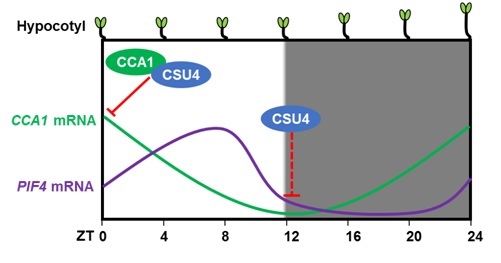On October 23, 2018, Professor Xing Wang Deng from the Department of Biology, Southern University of Science and Technology (SUSTech) published an online research artical entitled “COP1 SUPPRESSOR 4 promotes seedling photomorphogenesis by repressing CCA1 and PIF4 expression in Arabidopsis” in “PNAS” journal. Dr. Xianhai Zhao, a post-doc at SUSTech, is the first author of the paper, and Professor Xing Wang Deng at SUSTech and Professor Dongqing Xu at Nanjing Agricultural University are the co-corresponding authors of the paper. This study was done in collaboration with Assistant research professor Dr. Yan Jiang at SUSTech; Dr. Jian Li at School of Advanced Agriculture Sciences, Peking University; and Professor Enamal Huq and Professor Z. Jeffrey Chen at University of Texas at Austin. The study was supported by SUSTech, the National Natural Science Foundation of China, Peking University – Tsinghua Life Science Joint Center.

The exogenous light signal and the endogenous circadian clock are two critical factors for directing growth and development in plants. CONSTITUTIVELY PHOTOMORPHOGENIC 1 (COP1) and DE-ETIOLATED 1 (DET1) are founding components of two central repressor complexes of photomorphogenesis that trigger the degradation of a larger number of photomorphogenic-promoting factors in darkness. Here, we identify COP1 SUPPRESSOR 4 (CSU4) as a genetic suppressor of the cop1-6 mutation. Mutations in CSU4 largely rescued the constitutively photomorphogenic phenotype of cop1-6 and det1-1 in darkness. Loss of CSU4 function resulted in significantly longer hypocotyl in the light. Further biochemical studies revealed that CSU4 physically interacts with CIRCADIAN CLOCK-ASSOCIATED 1 (CCA1) and negatively regulates its transcriptional repression activity toward its targets. CSU4 represses the expression of CCA1 in the early morning and of PHYTOCHROME INTERACTING FACTOR 4 (PIF4) in the early evening. Our study suggests that CSU4 acts as a negative regulator of CCA1 via physically associating with CCA1, which in turn, likely serves to repress expression of CCA1 and PIF4 to promote photomorphogenesis.
Link to the paper: http://www.pnas.org/content/pnas/early/2018/10/22/1813171115.full.pdf
Proofread By
Photo By